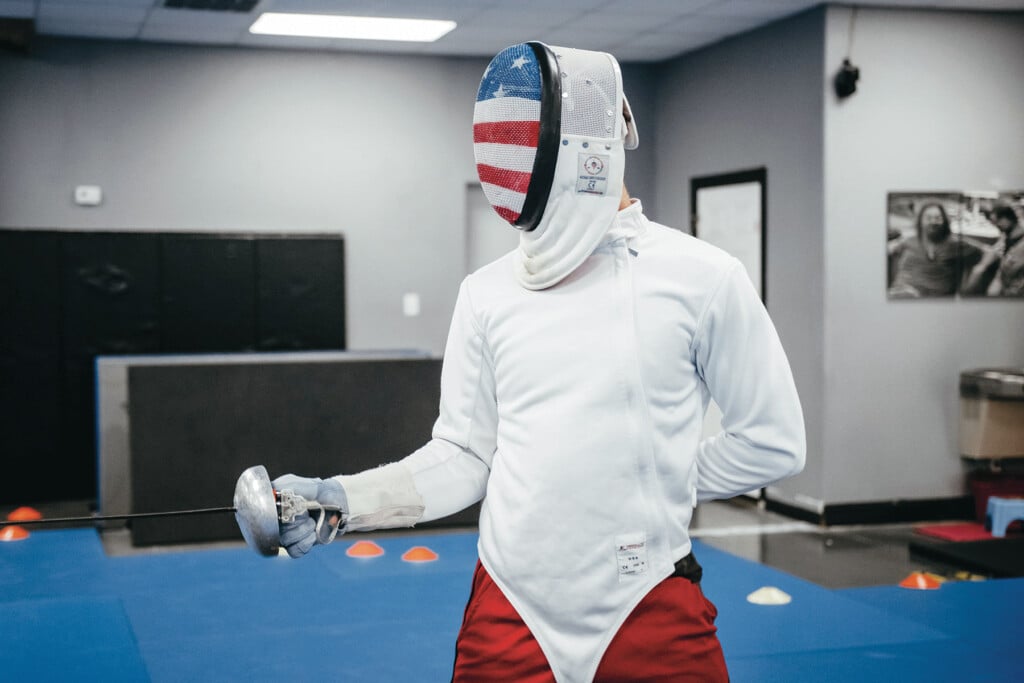En Garde
Former airman brings fencing to the Emerald Coast

When it comes to athletics on the Emerald Coast, fencing—with foils and sabers and épées—is not typically the first sport to come to mind.
Air Force veteran Peter Wetzel is on a mission to change that.
Wetzel opened Emerald Coast Blades in June 2024. The fencing school is designed to introduce local communities to the passion he first discovered at age 11 in Memphis, Tennessee.
“It’s super dynamic, super fun,” says Wetzel, who has competed at the college level in ACC and NCAA championships. “We want people who have no experience with fencing. If you think it looks cool, we’d love to teach you about it.”
Wetzel’s goal to make fencing accessible is proven across three Emerald Coast Blades locations in Pensacola, Gulf Breeze, and Crestview where training focuses on Olympic fencing and offers primarily beginner classes and open sparring.
“Not everyone is going to enjoy fencing, but most people think they’ll never have a chance to try it,” Wetzel says. “We provide equipment for anyone who wants to come in, and the first lesson is free.”
The former airman also launched the school with the military in mind.
“One of the reasons I wanted to start it was that I had a PCS [permanent change of station] a whole lot,” Wetzel says. “And one of the unfortunate side effects of that is you run out of things to do. You’ve got to make new friends!”
Since opening its doors, Emerald Coast Blades has welcomed a wide range of ages, backgrounds, and abilities.
“Fencing is a great sport in the sense that it’s not age-dependent and it doesn’t actually have that much of a body-type dependency,” Wetzel says. “You’re not at an advantage if you’re tall, and you’re not at a disadvantage if you’re short.”
A mix of athleticism and mental strategy, modern Olympic fencing is often referred to as “physical chess” because you can often outsmart an opponent through wit. Wetzel often reminds his students that fencing, at its core, is about solving the problem directly in front of them.
“There are many ways you could do it,” he says. “You can outmuscle them, outspeed them, you can outthink them, or you can just have better dexterity and hit them in exactly the right spots.”
To make sure students have all the tools necessary to win a bout on the fencing court, which is known as a piste or a strip, Wetzel starts every class with conditioning and works up to specific fencing technique.
“The most important muscles that we use in fencing are legs, obviously, for movement,” he says. “We also tend to use a fair bit of shoulders and arms. Another super important thing in fencing is balance, so having a strong core helps a lot.”
And while it might look graceful, fencing can provide the average adult with quite a workout.
“Once that mask goes on, all you care about is ‘OK, how do I not get hit and how do I hit them,’ which then burns a ton of calories and builds a lot of muscle,” Wetzel says. “I never realized until after college, when I was working a desk job, how awesome it was that I had this thing that has kept me active all my life.”
In the past year, the classes at Emerald Coast Blades have proven most popular among children and teenagers eager to try something new.
“Fencing is a fantastic sport for kids because it builds so much more than physical fitness,” says David Levine, assistant coach at Emerald Coast Blades. “It teaches focus, respect, and perseverance in a way that’s exciting and empowering. Kids stay mentally engaged while developing coordination, balance, and agility.”
And the whole playing-with-swords thing doesn’t hurt a bit.
“It’s also a great fit for kids who may not connect with traditional team sports,” Levine adds. “In fencing, they get one-on-one competition in a supportive, structured environment where personal growth is just as important as winning.”
Wetzel, who also played team sports growing up, says it was fencing that truly taught him to trust himself and his abilities.
“You are always 100 percent in control of whether you lose or you win, which is tough because when you lose, you’re like, ‘Oh, it’s my fault,’” he says. “And it’s exhilarating when you win. You’re like, ‘I did that!’ A lot of kids don’t have that opportunity.”
Whatever sparks the interest in fencing, Wetzel and Levine welcome everyone and will eagerly share their expertise.
“We want anyone and everyone to feel like they have a place here, whether they’re trying the sport for the first time or training for competition,” Levine says. “It’s a fun, encouraging environment where people can grow, challenge themselves, and just enjoy the thrill of fencing.”
Weapons
Foil A rectangular cross-section blade with a small bell guard.
Saber A flat blade with a knuckle guard, used with cutting or thrusting actions.
Épée A triangular cross-section blade with a large bell guard.
Terminology
Piste/Strip
The fencing field of play.
Allez
Go, Begin.
En Garde
Position taken before fencing commences.
Advance
Step toward one’s opponent.
Attack
Movement series by which a fencer tries to score a point and determine the right-of-way.
Fleche
Explosive, running attack (foil and épée).
Flunge
A combination of a lunge and a fleche (saber).
Guard
A fencer blocks an opponent’s blade.
Lunge
A common attack in which a fencer launches toward an opponent while maintaining a stationary back leg.
Recover
The return to the en guarde position after lunging.
Parry Defensive action in which a fencer blocks an opponent’s blade.
Riposte Defender’s offensive action immediately after parrying an opponent’s attack.



